Travelling Europe by Bike (and Train): Munich to Venice
Many years ago I noticed a sign post in Munich: This way to Venice on bike. Since then the idea has been developing, and this summer I had almost sufficient time off to get on the road from Munich to Venice. Almost: To cross the Alps and the Dolomites comfortably, in style and on the same motorless bike used in daily city traffic five days are not enough. In addition, the weather forecast for my first day off announced heavy rains on the way from Munich.
- Munich–Innsbruck by train and bike
- Brenner Pass and Puster Valley: Innsbruck–Terenten/Terento by train and bike
- Puster Valley: Terenten/Terento–Cortina d'Ampezzo by bike
- Cadore Valley, Piave river and the home of Prosecco: Cortina d'Ampezzo–Conegliano by bike
- Through the Veneto: Conegliano–Venice by bike
- Bike-friendly accommodation
- More to try
Munich–Innsbruck by train and bike
So we decided on a lazy start with a local train to Lengries in the afternoon. Starting off in perfect bicycle weather, we were soon caught by pouring rain. It turned out that on the German side, the bridge over the Walchen river was the only shelter on the route. The route itself followed a pattern common for all Bavarian bikeroutes I have taken so far: straight paved road for cars, much up and down and lots of gravel on the bikeroute. The reward: Breathtaking views over both, the Sylvensteinspeicher dam and the Walchen river.
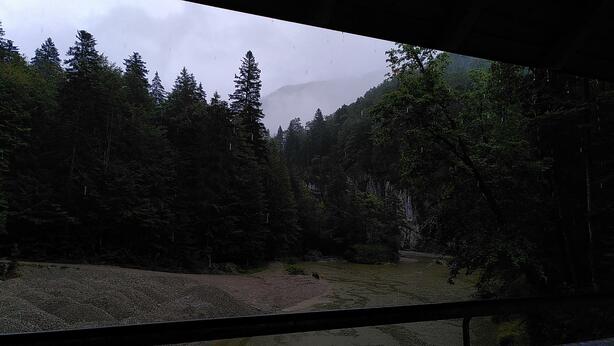
After the Austrian border cyclists are taken better care of: Most of the time the signposts guided us on separate or low-traffic ways, all paved. No need for a map or a GPS so far, all the way to Jenbach.
When we approached picturesque lake Achensee the rain had ceased but the sun already started to set. So there was no time to stop for an organic farmers' ice-cream ("Biobauernhofeis") at Seestraße, to the left of the gate to the public bathing beach at the Northern part of the lake and marvel its deserted beauty after the rain. So I'm really sorry I did not stop to map the ice-cream kiosk on OSM! A little further South I also noticed a shop advertising locally produced natural bodycare and organic herbs: Kräuterhüttl. Obviously, this is tourist land.
Instead we pedalled fast to reach a late urban train from Jenbach to Innsbruck where we arrived late. The twisting road downhill to Jenbach is steep – cyclists in Jenbach must be fit! In the dark and even though there was little car traffic at that time of the day it wasn't the fun it otherwise could have been. From Jenbach the urban trains S4 and S5 run by S-Bahn Tirol give cyclists a welcome and reliable shortcut all the way uphill to Innsbruck.
Brenner Pass and Puster Valley: Innsbruck–Terenten/Terento by train and bike
Given our tight time budget we decided to continue lazily the second day: The urban train S3 from Innsbruck to Brenner/Brennero is a comfortable shortcut for the tedious (and ugly) way uphill trusted by cyclists (not only lazy us). At the once nice border station between Austria and the Italian province of South Tyrol we waved good-bye to the ugly motorway E45 crowded with equally ugly cars.
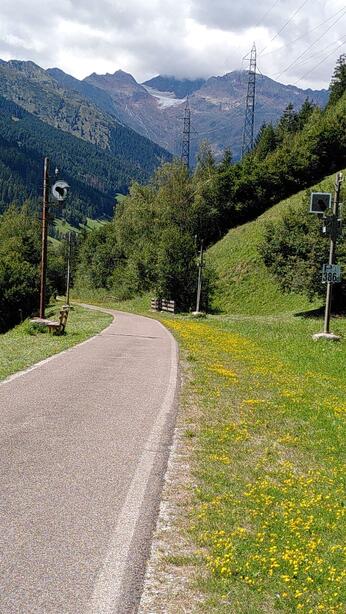
From here: let loose and roll on, on the track bed of the old train line over the Brenner Pass. Easy. Pedalling started around Sterzing. Lots of cyclists on the way (including families), but there was not a minute without the constant noise of fossile-fuelled passively moved obese cars on the motorway, always within hearing range, often within eye-sight.
The bicycle route is all paved and usually guarded with railings, and there are frequent signposts. However, be careful and watch out for the red horizontal stripes on the pavement: They are marking serious bumps which can be dangerous at the good speed you may gain.
Unfortunately the route avoids habitated placed, so for food you have to actively leave it as you certainly do not want to pick off the apples or corn ears along the way: Almost all of them are treated with pesticides.
For the night my partner wanted to find a nice, eco-friendly hotel – and made the mistake to trust in Google. So we left the bike route at Niedervintl/Vandoies di Sotto in the Puster Valley for Terenten/Terento. 600 meters difference in altitude divided upon only six kilometres, a proper work-out for the evening. Taking the twisting road uphill was not nice even though most car drivers behaved properly. We met the public bus no. 421 from Vintl/Vandoies station via Terenten/Terento to Bruneck/Brunico operated at an interval of half an hour (two hours on Sundays) during the day: It was nearly empty in both directions.
Arriving at the hotel it felt like becoming the talk of the town, other guests were looking at us in disbelief: Up here without an engine? When you see this nice village depending on car-driven tourism the necessary change seems impossible. Depressing.
Puster Valley: Terenten/Terento–Cortina d'Ampezzo by bike
After a quiet night with a beautifully starry sky we took the nicer road down from Terenten to Kiens. Here we met a handful e-bikers on their way uphill before we set out on our third leg to Cortina d'Ampezzo. This part of the route through the Puster Valley is hilly (approximately one kilometre difference in altitude) and passes through towns and villages.
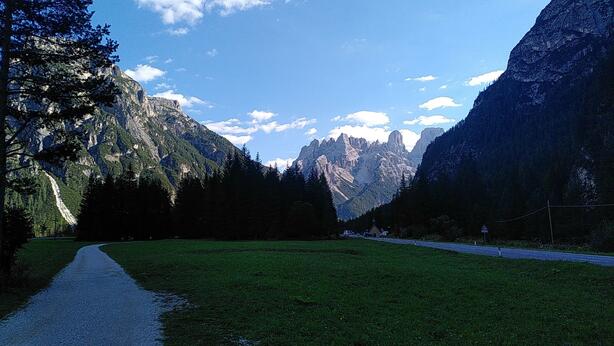
Most of the route is separated from motorised traffic but only partially paved. While the gravel parts after Bruneck/Brunico and along Lake Olang would be doable on a Dutch bike, the entire way from Toblach to Cortina with its breathtaking views on the UNESCO World Heritage of the Dolomites is a nuisance: gravel, gravel, deep gravel while the motorised traffic runs smoothly on the new-paved road within hearing range.
Interestingly, this leg of the route was the only part where oncoming cyclists wouldn't nod (or say) a greeting, not even return our greeting. The vast majority of them used e-bikes, probably car drivers no longer used to this comradely tradition of the hills.
On the pass at the border between South Tyrol and Belluno we decided to continue on the Strada Statale downhill as we wanted to reach Cortina before sunset: Apart from the constant danger of being steamrolled this road lives up to the standard other Italian long-distance bicycle routes definitely have.
Finally traffic congestion into Cortina and no way around for cyclists.
Cadore Valley, Piave river and the home of Prosecco: Cortina d'Ampezzo–Conegliano by bike
The fourth leg of the tour started nicely downhill on a paved separated bikeroute out of Cortina. At Località Socol the route u-turns to the left into the gravel nuisance of a hiking trail. Only after leaving the municipality of Cortina d'Ampezzo the route changes to a bicycle route worth the name.
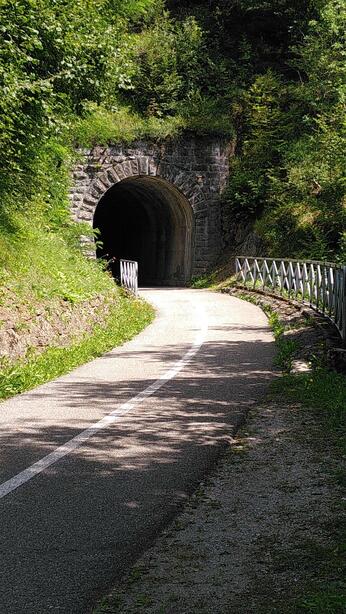
The fun starts on the former railway line to St. Vito di Cadore, and continues along the Cadore Valley. Comfortable cycling with great views. The only point without a route sign comes when you have to leave the former rail line for the approximately one kilometre difference in altitude downhill to the bottom of the valley.
This is where you start sharing the road with cars, but no worries: The neverending stream of passive mobilists is now using a new motorway (of which you don't hear much noise), and the old Strada Statale di Alemagna 51, nicely paved, is only for you and your downhill fun, occasionally shared with you by a local car. The contrary wind helped to slow down downhill (and the oncoming pedalists uphill). Hopefully the road will continue to be maintained for cyclists.
Unfortunately the fun stops when reaching the lowlands. On the remaining route to Prosecco land signs have been put up less frequently and only on short stretches active mobility is separated from passive. The landscape itself is interesting: the scarse flat shaped by the river Piave, through industrial zones, along lakes. But don't be mistaken: it's hilly, with only short flat stretches. Our day ended with a gorgeous, partially organic dinner in Conegliano.
Through the Veneto: Conegliano–Venice by bike
The final leg of the München–Venezia bikeroute is flat, dry and hot (in August). The usual Veneto bicycle route mix: leisurely alleys in the shade along the river, here and there separated communal bikelanes of varying quality, shared traffic on not too highly frequented roads. The route is marked but often with small signs easy to be missed.
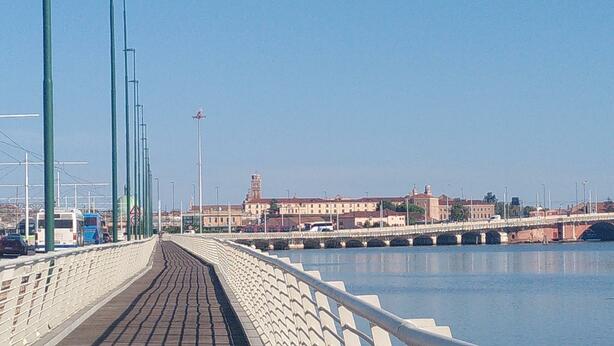
We did not follow the route strictly but cut off here and there on local bikeroutes. Arriving in Venice by bike is a breathtaking experience: The railway and road bridge Ponte della Libertà ("Freedom Bridge") connecting Mestre on the mainland shore with the city of Venice itself has a dedicated bicycle lane, and you see Venezia St. Lucia approaching in front of you.
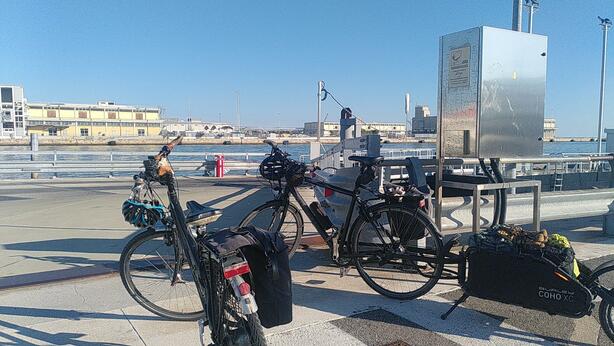
Bicycles in the waterborne city itself are naturally a nuisance, so we decided to stay on the Lido. Unfortunately there are no signs guiding cyclists from Piazzale Roma to the car ferry on the artificial island of Tronchetto. The ferry ride is an inexpensive pleasure – watch the city passing by from Giudecca Channel.
We did not take the bike back to Munich. Instead reliable Austrian Railways ÖBB gave us and the bikes a lift (to be safe we had bought the tickets and reservations well in advance).
Accommodation on the route
The route's official webpage has a directory of bicycle-friendly accommodations, but since you cannot simply search for a place its use is limited. More, (sometime the same) places can be found on the reliable Bett&Bike site run by Germany's bicycle association, the ADFC. Unfortunately none of these directories allows to filter for environment- and climate-relevant measures like organic breakfast, use of renewable energies or environment-friendly cleaning agents. These efforts towards sustainable tourism are taken into account by the EcoBNB platform.
Most other cyclists we met on the route had a tent with them, certainly the cheapest, but also the most uncomfortable way to spend the nights. We preferred to carry a minimum of luggage, and decided on a budget between 100 and 200 EUR for the night. Unfortunately this budget was too tight for the places I found where you probably could have a fully organic breakfast.
For the first and last stop, Innsbruck and Venice we booked accommodation upfront, but being unfamiliar with the route we decided on last-minute booking directly from the hotels.
The first night we spent at Hostel Marmota in Innsbruck. It has a spacious bicycle storage room in the basement which is locked during the night. Arriving late was no issue; even though the reception did not answer the phone. The bar did not offer any organic refreshments, but there was one type of organic tea and organic oat drink at the breakfast buffet. Clean, basic, no-frills room.
For the second night in the Puster valley my partner learned a lesson: Do not rely on Google Maps (personally I don't use Google services unless forced to): Even a few kilometers can be very long when they turn out to be uphill after a day on the bike. Our last minute booking call to Naturhotel Edelweiß in Terenten/Terento resulted in a very friendly price for a spacious, very nice, wood-furnished room including four-course dinner (for guests only).
The kitchen at this family-run hotel uses local ingredients, but isn't suitable for vegetarians. Also here the only organic items on the breakfast buffet were one type of tea and a plant-based drink (soy in this case). There's no storage room for bikes, but we were allowed to park directly in front of the hotel and turned out to be an attraction for car-dependent hotel guests.
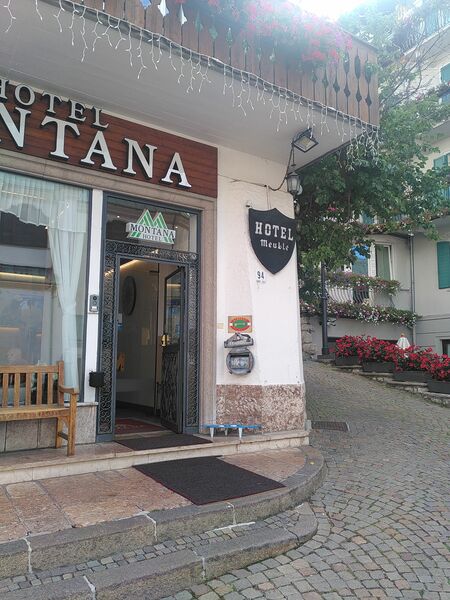
Famous for hosting the winter olympics of 1956 the 2022 version of Cortina d'Ampezzo in the Dolomites turned out to be a single expensive (though still quite elegant) pedestrian street in the middle of a car jam which even us on our bikes forced into a stop-and-go. The most expensive night of our tour we spent in a basic room with plush furniture at Hotel Montana with a very nice view from the balcony and the air of past grandezza. In addition to the one variety of organic tea and organic soy drink (by now experienced as a sort of minimal standard) the breakfast buffet offered one variety of organic blueberry jam! The hotel was listed as bike-friendly, and indeed, we could store the bikes in a crammed storage room dedicated to the purpose.
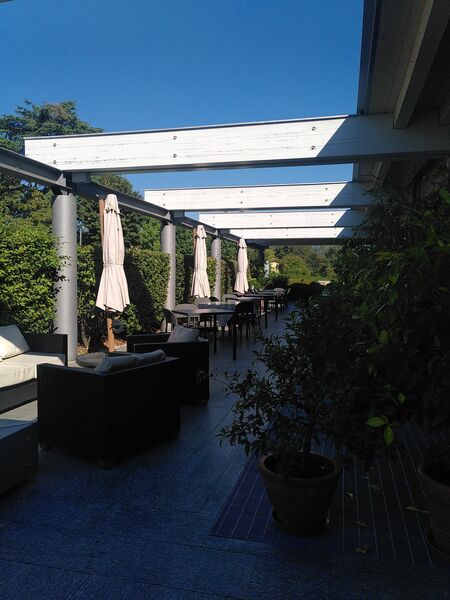
The last night on the way to Venice we spent in Conegliano, at Relais Le Betulle which we found at at EcoBNB. Their hotel restaurant, Enrica Miron, serves organic meat and eggs, and we were very satisfied with our carte blanche menu of the day. The breakfast buffet however did not offer more organic items than we by now found usual. There's no dedicated parking space for bikes; we were allowed to take the bikes on the (spacious) room (which had sufficient space on the balcony), but decided to use a car parking lot.
To find a bicycle-friendly accommodation at the final destination, Venice, is not so easy given the aquatic nature of the city. Riding a bike is possible on the Lido, and from a previous bike tour through the Veneto (via Chioggia) we knew that the friendly, family-run Villa Casanova would allow us to park the bikes in its backyard. From that visit we also knew not to expect any organic items on the breakfast buffet (not even tea and milk), despite the fact that the hotel advertises partially organic breakfast. But the rooms are pleasant and the price is friendly compared with Venice standard.
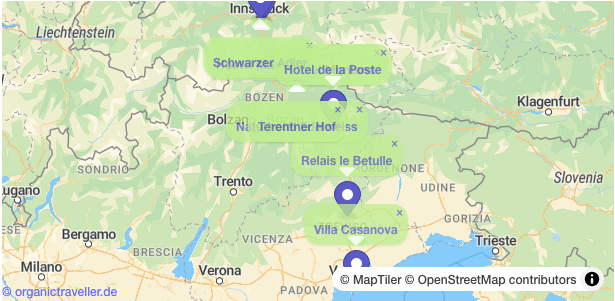
- Hostel Marmota, Tummelplatzweg 2, Innsbruck
- Naturhotel Edelweiss, Unterdorfstr. 6, Terenten/Terento
- Hotel Montana, Corso Italia 94 , Cortina d'Ampezzo
- Relais le Betulle, Via Costa Alta, 56, Conegliano
- Villa Casanova, Via Orso Partecipazio, 9, Lido di Venezia
More to try
For the following hotels I found sufficient evidence for use of organic produce in the kitchen and/or a significant part of organic food and drinks at the breakfast buffet, but I cannot give an eyewitness account.
2022-10-23 13:00:00 [The_Conscious_Traveller, MuenchenVenezia, Germany, Austria, Italy, Munich, Innsbruck, Terenten, Terento, Bruneck, Brunico, Cortina, Alps, Achensee, Pustertal, Puster_Valley, Dolomites, South_Tyrol, Alto_Adige, Suedtirol, Belluno, eco, trains, bikeroutes] Link
